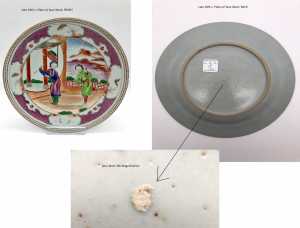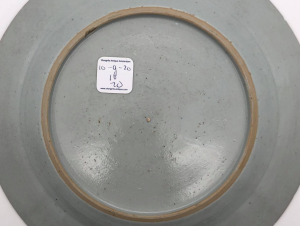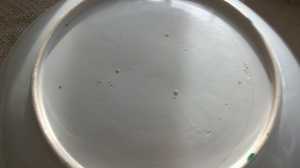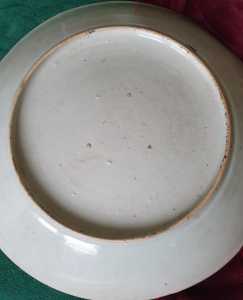The Chinese and Asian Art Forum. For Fans, Collectors and Dealers.
 Basic Rules For the BidAmount Asian Art Forum: Talk about whatever you want. You can even discuss and offer things that are for sale if they are authentic. Maximum image file size per post is 2 MB. Images of 700pxl x 700pxl are optimal if saved at a medium resolution. Be respectful of others and enjoy yourself. Click the YouTube link for a brief tutorial on using the forum. You can also EMBED Videos by cutting and pasting from You-Tube, Vimeo etc.
Basic Rules For the BidAmount Asian Art Forum: Talk about whatever you want. You can even discuss and offer things that are for sale if they are authentic. Maximum image file size per post is 2 MB. Images of 700pxl x 700pxl are optimal if saved at a medium resolution. Be respectful of others and enjoy yourself. Click the YouTube link for a brief tutorial on using the forum. You can also EMBED Videos by cutting and pasting from You-Tube, Vimeo etc.
NOTE: To post an item or add a new post, click open the category title from the FORUM LIST, and CLICK the Blue ADD TOPIC button.
Hi Brian, I do think that is a spur mark on the famille rose plate. I took the photo and have handled it under a loupe. I was referring to this plate.
John, that is so interesting to see, thank you. I could eat that Kangxi paste!
I think it could be a spur mark, I have some similar to that. How big is the plate? Could you please post a photo of the back?
When Peter is better, I want to ask him about the porcelain on some chargers I have. Two have been on here; I and others felt 19th c, but someone who has much experience in that type of item, said late 18th. I am struggling to see that, especially as I then picked up a Rose Mandarin plate with the same look to the porcelain - and a spur mark, I think. I believe it is early, around 1830, so I want to know if that confirms a dating for the other 2, but it may not if yours is the same.
Sorry, if that sounds jumbled! , Yours does look very like the bases on mine, only it won't let me enlarge it enough to see clearly if it does indeed share similar features.
Hi Julia! I'm glad you enjoyed looking at these little photos comparisons I made! It was actually your earlier comment that prompted me to include the decorations on the same photo for easy reference.
This plate feels very different from my other late 18th c. pieces, although the decoration would be right for the period. I got it from ShangriLa Antiques - they had it listed as 18th c. Qianlong. I'm not sure what to think of it, although It is exactly 23 cm in diameter, so I'm struggling to see the need for a spur on mine. I also don't recall the two you've referenced - I hadn't kept up with posts here earlier this year as often as I do now. Could you show me? 🙂 Here's the photo of the base of my plate:
Thanks, John. That looks just like it. Mine are all large, one definately doesn’t have a spur, but as with yours, the porcelain is of a different type to what I usually find. It was one of the Shangri-la guys who said mine were late 18th c.
I find it all a bit odd. I have even started wondering if they could be modern fakes, but it is only the porcelain that I find odd. I want to sell them as they are too big for our smaller house, but I need to be sure of my description. I think the photos have long disappeared, but I do have one accessible. Actually, there may still be a photo from the seller still available on line, it is a bit dark here for photos at the moment.
I will have a look.
@julia - That's very interesting. Do the decorations fit with the period on yours? I was wondering if it was soft-paste porcelain since mine is not translucent as my other porcelain, but it looks like it's not: https://www.gotheborg.com/glossary/softpaste.shtml
Given it is so thin, is not translucent, nor is soft-paste porcelain, I wonder if it is stoneware... All very odd and suspect - I had this one listed on bidamountlive, so I'm glad you brought it up. I just removed it. I just assumed given it was from shangrila and the decorations look right that it was correct.
No, I don't think so: there is no crackle and it has different look. Just on my pc now looking to see if I have the photos.
Oh dear, the photos are dreadful! This is the best one I have for the purpose of the base - it is s a rather grayish but also rather wheaten colour. Hard to explain. This is more dish shaped.
This is another base, no doubt that these are spurs as they are the same shape. The base has sagged a bit. This has a blue tinge to the glaze but the same impurities and tone to the paste.
Actually the impurities don't show up that well in those, all 3 have lots of little black flecks - and at least one plate, has some larger ones.
Hi Julia, yes, I completely understand - those two are clearly the same as my plate, although mine is smaller. I looked into it a bit. Are you still a member on Gotheborg? I searched on there "spur" under the topic "Chinese Western Market Export Porcelain" and the first result has a couple of dishes that may be part of the same group as ours. They seem to agree that these dishes with spur marks are still mid-late 18th century.
Thanks, I am member and will go and look. The thing is, they can't all be 18th c as the rose mandarin one is clearly a q9th c design. It was sold as late, I think it is early, but I am talking around 1830. That date may fit the other two plates, but now I have seen yours I am starting to wonder if the clay came from a certain area/kiln as it is distinctly different
That is what I was going to ask Peter. I will let you know if I find out anymore.
Dear John, you are very right, they were masters in potting.
I have no experience in potting, nevertheless it is amazing to see how they have been able in throwing eggshell bowls, for example, or the uniform thinness of Kraak dishes.
I am busy currently because I am cataloguing my collection; I started cataloging snuff bottles first. In checking if they are glazed or unglazed inside, I am introducing a LED light. In doing so, I am amazed in seeing how the body of such small objects has an incredibly thickness uniformity. I have no idea about how they could reach that.
Regards,
Giovanni
Thank you for sharing those observations, Giovanni. I will say, the difficulty is further compounded when you consider how finely levigated the clay was. That very fine consistency would make it more difficult for throwing on a wheel. Modern clay for beginners even include small crushed-down pieces of fired clay to help the clay body "stick together" easier. I've yet to even make something as thin as egg-shell porcelain with that kind of beginner clay much less porcelain as fine as the early 18th c., at least without it ripping apart in front of me. It is very impressive!
I would love to see your snuff bottle collection one day. Are you cataloging it online? I'm also curious how glazing the inside would affect its utility. I know very little about snuff bottles.
Dear John, it is my intention to compelte the cataloguing and then share it online, but it will take time.
Snuff bottle glazed inside is more "clean" but it is not so important. Some believes that older bottles are not glazed inside but I have no sure proof of that.
Giovanni
Thanks for visiting "The BidAmount Asian Art Forum | Chinese Art"
If you sell on eBay, or have a shop feel free to post images and descriptions and links.
Check back often for discussion about the latest news in the Chinese art and antique world. Also find out about the latest Asian art auctions at Sotheby's, Christie's, Bonhams and Tajans.
Auction results for: fine porcelain, ceramics, bronze, jade, textiles and scholar's objects. As well as Japanese, Thai, Vietnamese and other Asian cultures.
Thank you,
Peter Combs
Topics and categories on The BidAmount Asian Art Forum | Chinese Art
Kangxi vases, Kangxi dishes and chargers, Kangxi ritual pieces, Kangxi scholar's objects, Qianlong famille rose, Qianlong enamels, Qianlong period paintings, Qianlong Emporer's court, Fine porcelain of the Yongzheng period. Chinese imperial art, Ming porcelain including Jiajing, Wanli, Xuande, Chenghua as well as Ming jades and bronzes.
The BidAmount Asian Art Forum | Chinese Art
A free Asian art discussion board and Asian art message board for dealers and collectors of art and antiques from China, Japan, Korea, Thailand, Cambodia, Vietnam and the rest of Asia. Linked to all of the BidAmount Asian art reference areas, with videos from plcombs Asian Art and Bidamount on YouTube. Sign up also for the weekly BidAmount newsletter and catalogs of active eBay listing of Chinese porcelain, bronze, jades, robes, and paintings.
The art of calligraphy - and for the ancient Chinese it certainly was an art - aimed to demonstrate superior control and skill using brush and ink. Calligraphy established itself as one of the major Chinese art forms during the Han dynasty (206 BCE - 220 CE), and for two millennia after, all educated men were expected to be proficient at it.
The Museum’s collections of Asian art span nearly five millennia and encompass the cultures of China, the Himalayas, India, Japan, Korea, and Southeast Asia. In 2007, the Museum launched an initiative to create dedicated galleries for the collection, beginning with a gallery for the arts of Korea ...
Chinese art is full of symbolism, in that artists typically seek to depict some aspect of a totality of which they are intuitively aware.
China Online Museum is the finest online museum of Chinese art. It features Chinese calligraphy, painting, ceramics, bronzes, carving, and other artworks.
Chinese Ceramics & Works of Art. Overview Upcoming auctions Contacts Auction results ... Christie’s sales of Chinese ceramics and works of art showcase centuries of Chinese history. Held throughout the year in London, New York, Paris and Hong Kong, they attract a wide audience of collectors and connoisseurs vying for pieces as diverse as ...
Explore Asian Art Week. Contact the Specialist Department. Chinese Paintings ... Senior Specialist, Head of Sale. [email protected]. Tel:+1 212 641 5760. Bid in-person or online for the upcoming auction:Fine Chinese Paintings on 10 September 2019 at New York. Bid in-person or online for the upcoming auction:Fine Chinese Paintings on 10 ...
Discover an abundance of must-see art from all corners of a vast continent at Christie’s NY Asian Art Week. From contemporary classical and Chinese paintings to works with exemplary provenance from the Art Institute of Chicago, our Rockefeller Paza galleries will be full of ancient treasures and contemporary masterworks in a salute to the vibrant arts of Asia.
Sold to benefit The Art Institute of Chicago’s Asian Art Acquisition Fund, the sale features 84 lots with a focus on Ming and Qing porcelains, and offers a rare insight into the taste for collecting Chinese ceramics and works of art in the Midwest from the end of the 19th century through the 1980s. Highlights include two Wanli wucai garlic-head vases, a Qianlong mark and period, blue and ...
Specialist, Chinese Paintings, Christie's London Dr Malcolm McNeill is a Specialist in Chinese Paintings at Christie’s, based in London. He previously worked as an assistant curator of the Chinese collections and the Victoria and Albert Museum in London, as a researcher at the British Museum, and as a translator and tour guide at the National Palace Museum in Taipei.
The Christie's Education 2020 Conference: The Chinese Art Market 18 Jun 2019 Christie’s Education is delighted to announce our first international academic conference in Asia which will take place in Hong Kong from 26-27 November 2020 at the Hong Kong Convention and Exhibition Centre and will run in parallel with Christie’s Hong Kong Autumn Auctions.
The summer Chinese Art sale in Hong Kong will feature works of art from several private collections, including Qing porcelains and textile from the collection of the legendary Chinese art dealer A. W. Bahr (1877–1959), fine gilt bronze Buddhist sculptures from an old Hong Kong collection, an East Asian collection of Qing dynasty wine cups and jades, and a Japanese collection of Song ceramics ...
Sotheby's Chinese Works of Art Department holds two auctions each year in London, New York, Hong Kong and Paris.
Chinese Art - View Auction details, bid, buy and collect the various artworks at Sothebys Art Auction House.
With more than 340 Chinese works of art dating from the Neolithic to the Republic periods, highlights of this sale include a selection of Qing Imperial monochromes from the collection of Arnold and Blema Steinberg, early ceramics from the Art Institute of Chicago and Chinese porcelain and works of art from the collection of Henry Arnhold.
Results: Sotheby's Asia Week achieved $52.4 million in six strong auctions, exceeding pre-sale estimates. With 76.5% of lots sold and 60.3% of lots surpassing high estimates, the Asian art sales at Sotheby's indicate continued collector interest in the finest works of art from China, India and and the Himalayas.
Today's sale of Important Chinese Art will proceed as planned with sessions at 10 AM and 2 PM EDT. Sotheby's will be monitoring the weather conditions throughout the day and will be available to coordinate alternative bidding options should conditions make it difficult for clients to attend the auction in person.
Bonhams Chinese Art department is renowned for offering the finest works of art representing the richness and breadth of China's artistic heritage, particularly Imperial porcelain, white and spinach green jades, cloisonné and Buddhist art. Specialised international auctions are held globally, including London, Hong Kong and San Francisco.
Bonhams : Chinese Works of Art We use cookies to remember choices you make on functionality and personal features to enhance your experience to our site. By continuing to use our site you consent to the use of cookies. Please refer to our privacy and cookie policies for more information.
Bonhams Fine Art Auctioneers & Valuers: auctioneers of art, pictures, collectables and motor cars. We use cookies to remember choices you make on functionality and personal features to enhance your experience to our site. By continuing to use our site you consent to the use of cookies. ... Chinese Art (US) General enquiries
Bonhams : Fine Chinese Art We use cookies to remember choices you make on functionality and personal features to enhance your experience to our site. By continuing to use our site you consent to the use of cookies. Please refer to our privacy and cookie policies for more information.
Bonhams Fine Art Auctioneers & Valuers: auctioneers of art, pictures, collectables and motor cars Bonhams : Asian Art We use cookies to remember choices you make on functionality and personal features to enhance your experience to our site.
Bonhams are international auctioneers of fine Chinese and Japanese art. We specialise in rare Imperial and Export Chinese ceramics and works of art, as well as Japanese ceramics, fine and decorative works of art from the Neolithic Period to the 20th century. View on map
Bonhams Fine Art Auctioneers & Valuers: auctioneers of art, pictures, collectables and motor cars. We use cookies to remember choices you make on functionality and personal features to enhance your experience to our site. By continuing to use our site you consent to the use of cookies. ... Asian Art Bonhams. Work. 22 Queen St.




